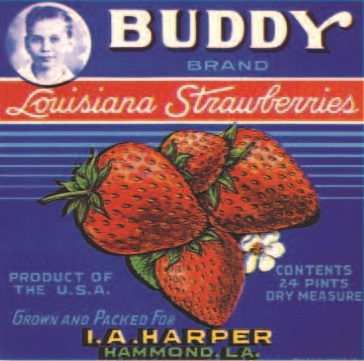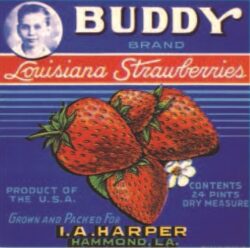Summer 2010
Strawberries
Published: June 16, 2021
Last Updated: August 23, 2021

Oh dey’s so fresh an’ fine
An dey’s just off the vine
Strawberry, strawberry, strawberry.
The composer uses the woman’s plangent call to signal daybreak over Catfish Row. Gershwin’s opera was in Charleston, S.C., but the same voices cried out their wares on New Orleans streets for centuries. Lafcadio Hearn reported in an article dated July 21, 1881, titled “Voices of Dawn,” that tignon-wearing women in the Crescent City gave particular vocal cadence to the sale of “Straw-BARE- eries!”
Today, it is the rare New Orleanian who can purchase food from a street vendor, but you can still find farmer’s markets. I’m always thrilled when I see the first flats of fragrant red strawberries arrive from Tangipahoa Parish, but I always wait a few weeks for them to grow in sweetness as their growing season reaches its peak.
Strawberries (Fragaria × ananassa) are members of the rose family, and thought to be relatives of the blackberries. Botanist E.J.H. Corner of Cambridge University believed that the berries were originally flowering plants millions of years ago in tropical regions. Botanists claim that the strawberry is circumpolar, and variants of the plant are found in both Old and New Worlds, where it flourishes in temperate zones. The English word strawberry comes from the verb “strew,” implying that the berries seem to have been flung to the winds in their wild form. The Latin genus name Fragaria refers to the fruit’s fragrance. Curiously, the strawberry is a “false” or” accessory” fruit. The tiny seeds on the outside of the berry are the actual fruit, while the red berry itself is the engorged stem of the plant.
The first strawberries to be consumed by humans were certainly the small wild ones known as fraises des bois or wood strawberries. Strawberries do not appear on ancient Greek menus and there is no evidence of them in Egyptian tomb art. The Romans knew the berry, but it seems to have been found only in the wild and resisted their attempts at cultivation. By 1368, though, strawberries were growing in the royal gardens at the Louvre, and by the 15th century the berries were hawked on the streets of London by vendors who were the ancestors of Gershwin’s character. Shakespeare mentions strawberries in Richard III.
When Europeans arrived in this country for the first time, they were amazed by the abundance of fruit growing in the wild. One colonist opined, “Wee can not sett downe foote but tred on strawberries.” Another added that he’d found berries “as good and great as those we have in England.” Roger Williams reported from Rhode Island, “This berry is the wonder of all the fruits growing naturally in those parts … In some parts where the Indians have planted them, I have many times seen as many as would fill a good ship within few miles compass.” He also noted that, “The Indians bruise them with a Morter [sic], and mixe them with meale and make strawberry bread.”
The American strawberry, Fragaria virginiana, arrived in Europe around 1624 and triumphed. Its larger size and brilliant color trumped that of the smaller European fruit, Fragaria vesca, but did not improve on its flavor. Henry Walpole’s Strawberry Hill was so named because Virginia strawberries were grown there. Later, in 1712, the Chilean strawberry, Fragaria chiloensis, which grows from Alaska to Patagonia, arrived in Europe, and hybridization began to produce some of the strawberry varieties that we know today.
By 1776 French botanist, Antoine Nicolas Duchesne, gardener to Louis XV wrote a Natural History of Strawberries and listed 300 varieties that could be obtained in Europe. By the French Revolution they were in wide usage. Madame Thérésa Tallien, Josephine Bonaparte’s mentor and flamboyant courtesan of the Revolutionary period, used the juice of crushed strawberries for her bath as a skin softener and for the fruit’s reputed healing properties. Herbalists credited the plant with astringent properties and thought it good as a cure for diarrhea. It was also used as a salve for sunburn and as toothpaste to clean discolored teeth.
Closer to home, in South Louisiana the Natchez Indians had a 13-month lunar calendar in which each month was named for the foodstuffs that were most abundant. For them, the second moon, which corresponds to our April, was Strawberry Moon. During that period, according to la Page Du Pratz’s 1758 account of Natchez life, “the women and children collect them in great quantities…” so it seems fitting that we have kept up the old traditions in the 21st century. For almost 40 years, people have gathered to celebrate the fruit’s harvest atthe Ponchatoula Strawberry Festival. Located about 50 miles north of New Orleans, Ponchatoula has long been known as the “Strawberry Capital of Louisiana.” A combination of botany, geography, invention and interstate commerce combined to make the city one of the hubs of American strawberry cultivation. Near the turn of the 20th century, the invention of the refrigerated railroad car, growing rail lines from New Orleans to Chicago and the hybridization of a hearty berry that could be packed and would travel well, signaled the city’s destiny. A Strawberry Festival Board was founded in 1971 to celebrate the city’s claim to fame, and the first festival was held in 1972. It boasted 11 booths and drew 15,000 visitors. Today, Ponchatoula is crowded with more than 300,000 people drawn to consume all things strawberry.
Even when I miss the Strawberry Festival, I can still indulge in some strawberry shortcake prepared with Tangipahoa Parish’s renowned strawberries from a favorite dessert cookbook, Dam Good Sweet, by David Guas with Raquel Pelzel. The collection of recipes lives up to its subtitle, Desserts to Satisfy Your Sweet Tooth New Orleans Style. Guas pays tribute to the city’s love for everything sweet, from beignets to spoon sweets to candy. There’s a gateau de sirop, a lemon icebox cake, a wicked fig jam, lemon curd, red pepper jelly, strawberry jam, vanilla, chocolate, and banana rice puddings, and on page 70—Ponchatoula Strawberry Shortcake! Per the main ingredient, follow Guas’s crusade to keep traditional Louisiana heritage strawberries in production—varieties like the Daybreak, Headliner, Klondike, or Tangi—a cause that the Slow Food Ark of Taste Committee has also undertaken. Then, following the cookbook’s instruction, instead of the usual biscuit, bake a brown butter cake to counterpoint the flavor-filled berries. Whisk up a big fluff of cream and indulge. You’ll soon understand why the strawberry replaced the cantaloupe as Louisiana’s official state fruit in 2001.
Jessica B. Harris, Ph.D., is the author of eight books documenting the foods and foodways of the African diaspora.
